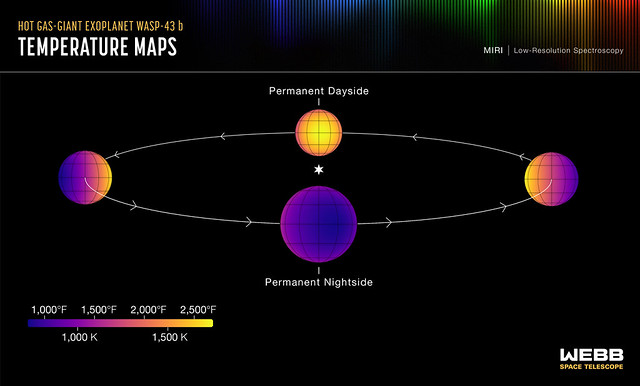James Webb Space Telescope Feed Post
Hot Gas-Giant Exoplanet WASP-43 b (Temperature Maps)
This set of maps shows the temperature of the visible side of the hot gas-giant exoplanet WASP-43 b, as the planet orbits its star. The temperatures were calculated based on more than 8,000 brightness measurements of 5- to 12-micron mid-infrared light detected from the star-planet system by MIRI (the Mid-Infrared Instrument) on NASA’s James Webb Space Telescope. In general, the hotter an object is, the more mid-infrared light it gives off. Because WASP-43 b orbits so close to its star (about 1.3 million miles, or 0.014 astronomical units), it is tidally locked: One side faces the star at all times, receiving continuous radiation, while the other faces away from the star in permanent darkness. This results in a clear temperature difference between the dayside and nightside. The amount of infrared light detected from the planet is greatest when the hot dayside faces the telescope, just before and after it passes behind the star (a phenomenon known as a secondary eclipse). The planet appears much dimmer in infrared light when the cooler nightside faces the telescope, as it moves across the star (the transit). The exact difference in temperature, however, also depends on factors such as wind speeds and cloud cover. Based on the MIRI observations, WASP-43 b has an average temperature of about 2,280°F (1,250°C) on the dayside and 1,115°F (600°C) on the nightside. This is consistent with strong winds that carry heat around from the dayside to the nightside, and the presence of nightside clouds that prevent heat energy from escaping to space. The temperature maps were made by carefully analyzing the change in temperature as different parts of the planet rotate into and out of view. The research indicates that the hottest point on the planet is not the point that receives the most light from the star (the substellar point, where the star is straight above in the sky). Instead, it is shifted about 7 degrees eastward. (This is why the maps look slightly off-center.) This is a result of strong equatorial winds, which blow at speeds upwards of 5,000 miles per hour, moving the hot air horizontally before it can radiate energy back out to space. Learn more: science.nasa.gov/missions/webb/nasas-webb-maps-weather-on... Credits: Illustration: NASA, ESA, CSA, Ralf Crawford (STScI) Science: Taylor Bell (BAERI), Joanna Barstow (The Open University), Michael Roman (University of Leicester) Image Description: Graphic titled “Hot Gas-giant Exoplanet WASP-43 b: Temperature Maps; MIRI Low-Resolution Spectroscopy” showing purple to yellow temperature maps of planet’s telescope-facing hemisphere at 4 orbital positions. Gray line with arrows pointing counterclockwise forms orbital path around star. Temperature scale at lower left, labeled in °F and K, grades from purple at left to yellow at right: 1,000°F is purple; 1,500°F pink; 2,000°F orange; 2,500°F yellow. 1,000 K dark pink. 1,500 K orange-yellow. Planet behind star, labeled “Permanent Dayside”: Hemisphere is yellow in center, grading to orange at edges. Planet left of star: Color grades from yellow at right edge facing star to purple at left edge facing away. Planet in front of star, labeled “Permanent Nightside” is purple slightly right of center, grading to dark pink at edges. Planet right of star: Color grades from yellow at left edge facing star to purple at right edge facing away. Image & Description by NASA
